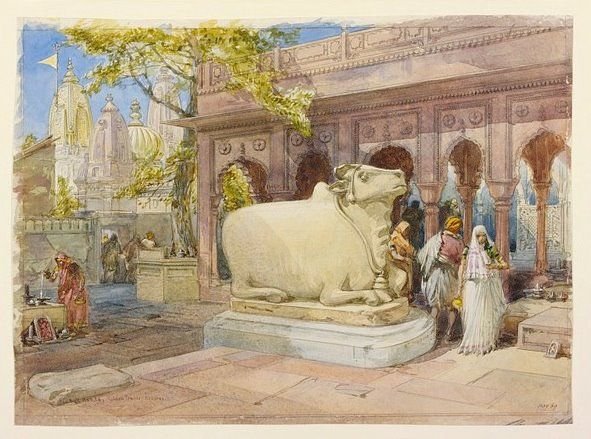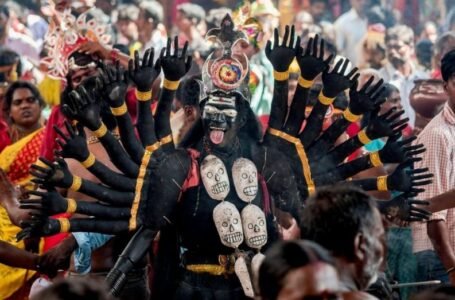Kashi Vishwanath Temple: The Spiritual Heart of Varanasi

The Kashi Vishwanath Temple in Varanasi of Uttar Pradesh in India is one of the most respected temples in Hinduism. The temple stands for Lord Shiva and enjoys recognition as a landmark where spiritual enlightenment and religious devotion merge. Kashi Vishwanath, also known as the Golden Temple of Varanasi for its gilded spires, is a remarkable site of mastery, a stronghold of cultural and mythological beliefs that has forged the spiritual foundation of India for millennia.

For Hindus, Varanasi, or Kashi, is considered the city of liberation, of which the Kashi Vishwanath Temple serves as the centre. The sanctity of the temple is bound by the ties of Hindu mythology and the indomitable spirit through the flow and ebb of time. It attracts thousands of devotees yearly who come seeking Lord Shiva’s blessings for salvation and inner peace.
History of Kashi Vishwanath Temple
The temple history is as old as the town of Banaras, one of the oldest continuously populated towns. Through centuries, the temple has seen destruction and uprising, resonating with the spirit of resilience and spiritual pursuits of the people in Banaras.

The original structure is believed to have come into existence for the very first-time thousands of years back. Kashi Vishwanath is mentioned in ancient Hindu texts like Skanda Purana, Shiva Purana, and Kashi Khanda. These texts call it the ”centre of the universe”’ and think of it as the seat of the eternal abode of Lord Shiva’s incarnation as Vishwanath, ”Lord of the Universe.”
Its recorded history shows that it was first destroyed in the 11th century by Mahmud Ghori. Hindu kings reconstructed the temple, but it was destroyed many more times, the ones recognized being the works of Qutb-ud-din Aibak and much later by Sultan Mahmud Shah. The most notable and disputed to this day is its destruction in 1669 by the royal decree (farman) by Mughal Emperor Aurangzeb and the forced construction of Gyanvyapi Masjid. However, each time, the temple would rise from the debris, reflecting the indomitable spirit of the Hindu devotees.

The present structure, started by Queen Ahilyabai Holkar of Indore in 1780, was built again at its original spot. She was responsible for restoring its sanctity and splendour. The golden spires that now crown the temple were the handiwork of Maharaja Ranjit Singh of Punjab, who contributed as much as 1,000 kilograms of gold to the task back in 1835.
The Kashi Vishwanath Corridor Project is an ambitious project of the modern state of India, initiated in 2021. The temple complex has vastly altered under the project, improving accessibility whilst holding onto the spiritual essence. The project connects the temple to the ghats of staying afloat in the sacred waters of Ganga for pilgrimage.
Mythology Surrounding Kashi Vishwanath
No other legend captures the mythic significance of the Kashi Vishwanath Temple in the rich world of Hindu cosmology and its legends. The city of Kashi is itself regarded as Lord Shiva’s beloved abode, and the temple is supposed to be where the might of his presence is the highest.
According to Hindu mythology, Varanasi was founded by Lord Shiva himself; thus, it is one of the holiest cities to visit. The city of Kashi is described in the Skanda Purana as a city that transcends time and destruction. At the fountainhead and in the heart of the city, the Vishwanath Temple is considered to be the jyotirlinga that grants liberation (moksha) to those who visit and worship there.
An equally famous legend regarding the temple, entwined in the traditions of Hindus, is the one narrated in the Matsya Purana about how Lord Shiva and Goddess Parvati, seeking repose for meditation, came to Kashi, the location that Shiva declared his permanent home. This sacred ground on which the temple stands developed into the core of devotees in search of blessings and liberation.

Another famous religious story relates to the jyotirlinga worshipped in the temple. The Shiva Purana says that the Kashi Vishwanath Linga is one of the 12 most holy jyotirlingas representing Shiva in his shining form. It says that even in the apocalypse (pralaya) when the entire universe is blanketed by water, the jyotirlinga at Kashi remains intact, representing the indestructible essence of Shiva.
The temple also plays a significant role in the tale of Ganga’s descent on Earth. Legend has it that Mahadeva allowed the sacred river Ganges to flow through his unkempt hair to purify the world. Many pilgrims visiting Kashi Vishwanath Temple take a holy dip in the Ganga to cleanse themselves before offering prayers at the temple, which connects the divine river with the temple’s spiritual power.
Architecture and Features
Besides the Hindu religious significance, Kashi Vishwanath Temple showcases the glory of India’s artistic heritage. The temple tower, lavished with gold, glimmers against the backdrop of the city, signifying divine brilliance.
The temple compound consists of several temples of Goddess Annapurna, Lord Ganesha, and Lord Hanuman. The sanctum sanctorum, the chief object of worship here, houses the jyotirlinga. Pilgrims pour water, milk, and flowers over the lingam in hopes of prosperity and salvation.

Apart from its turbulent history, the temple is vibrant in a spiritual atmosphere, and the procurement of modern amenities adds to the infrastructure while keeping its sanctity intact. The newly added Kashi Vishwanath Corridor has enhanced the commutation around the temple, providing the devotees space and kindness for worship.
Spiritual Practices and Worship
The Kashi Vishwanath Temple is a hotbed of spiritual activity, with pujas and prayers conducted every day from sunrise to sunset. The day commences with the Mangala Aarti, which represents the morning awakening of divinity. This prayer consists of Vedic hymns with offerings of sandalwood paste and other sacred items.
The Special Puja of Shuddhi (purification) of the jyotirlinga in a rite called Rudrabhishek is performed whereby it is bathed with water, milk, and honey along with the recitation of Rudram, a hymn dedicated to Lord Shiva.
The month of Shravan (July-August) is the holy season for Shivaratri, when devotees flock to the temple to offer special prayers and fasts, said to be especially propitious for Shiva worship.
During Mahashivaratri, the festival of Lord Shiva, the temple sees a congregation of many devotees who pour in to offer prayers, while the atmosphere pulsates to hail the cosmic dance performed by Shiva through colourful processions in the town.

Cultural and Spiritual Significance
The Kashi Vishwanath Temple is an eternally beneficent temple, an artistic spectacle, a philosophical riding school, a social springboard, and a cultural and spiritual centre that inspires art, literature, and philosophy for centuries. No artist, poet, or philosopher can escape the glowing influence of the temple and its surroundings, from Adi Shankaracharya through Tulsidas and Kabir.
The Kashi Vishwanath Temple is considered a once-in-a-lifetime pilgrimage for the devotees, as it is believed to lead them towards liberation. The temple’s spiritual aura is amplified manifold by the chanting of mantras and the flowing Ganges, which culminates into a place tranquillity and emotional concentration.
The temple also embodies the beating heart of the local community. The pulse of Varanasi exists in daily prayers, rituals, and festivals performed in the temple, thereby reinforcing the identity of Varanasi as a city of spirituality and learning.
Impact on Hindu Spirituality
The Kashi Vishwanath Temple is, thus, the nucleus of the Hindu spiritual matrix, indicating the supreme valour of faith in the face of impending extermination. Its association with Lord Shiva, the destroyer of evil and the granter of liberation, gives light to the darkened hearts of millions.
The Temple is not limited to its religious significance but epitomizes the trend of Indian culture that, no matter how much time passes and how often civilization challenges it, it always survives and endures. It gives all those seekers a chance to connect to their inner divine, empowering them to contemplate eternal truths of life.

Conclusion
More than a cherished holy site, Kashi Vishwanath Temple is characterized as a vibrant repository of India’s spiritual heritage. It moreover evokes devotion and awe, with a history so drenched with mythological narratives and endurance. The shrine is a mystic initiation into a realm, where the universe is suspended, inside the holy presence of Lord Shiva, to the pilgrims as well as ordinary visitors.
Lord Shiva’s city and the Kashi Vishwanath always persist as an everlasting protector of Varanasi, throwing light on the life trajectory of any spiritual seeker so that the human race can be reminded of the immortality of faith, devotion, and liberation. It is thus the hallmark of rich religious and cultural history; an eminent host of divine grace and celestial piety.


